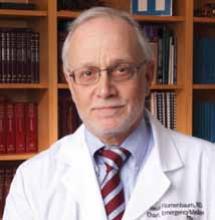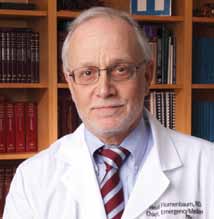User login
Charlotte Yeh, MD, former chief of emergency medicine at Newton Wellesley Hospital and at Tufts Medical Center in Massachusetts before becoming Regional Administrator for CMS in Boston, is currently the chief medical officer for AARP Services. On a dark, rainy night in December 2011, Dr Yeh was struck by a car while crossing an intersection in Washington, DC.
After being placed on a backboard and C-collar, she was transported by ambulance to a Level I trauma center where, without identifying herself as an EP, she became another injured patient in a crowded ED.
The experiences Dr Yeh relates in the June 2014 issue of Health Affairs (http://content.healthaffairs.org/content/33/6/1094.full), which were also excerpted in the June 9, 2014 edition of the Washington Post (Go to washingtonpost.com and search for “Yeh.”), sound all too familiar, and none too comforting.
The triage nurse repeatedly asked Dr Yeh where in the car she was sitting despite her responses that she was not in a car but hit by a car—a “pedestrian struck” as they say in NYC. After triage, her pain was addressed, primary and secondary surveys were completed, and focused exams were conducted to enable safe removal of the C-collar and backboard. So far so good.
But over the next 2 days, Dr Yeh’s repeated complaints about knee and gluteal region pain went unaddressed, even as CT scans of the abdomen and pelvis, and X-rays of the chest were ordered and completed. When she returned to the ED from Radiology, Dr Yeh was “parked in a hallway” where she remained through the night after being informed by a new group of clinicians that she was going to be admitted, but “boarded” in the ED until an inpatient bed became available. After 15 hours, the day crew arrived and, recognizing that Dr Yeh was an EP, moved her from the hallway to a private ED room.
Later in the day, the trauma team informed Dr Yeh that with nothing broken, and no major injuries turning up since she arrived, she could go home—despite her excruciating pain and still unexamined knee and hip. After a physical therapy team realized that she could not stand up, the surgical resident told her “there’s no medical reason to admit you…but if you can’t walk, we’ll just have to.”
Upstairs in the first available bed (on the maternity ward!), she repeatedly requested a knee examination before an orthopedic consultant determined that Dr Yeh had a medial collateral ligament tear requiring splinting until an MRI could be obtained. Other lapses in care included a failure to identify early-on the sciatic and gluteal nerve contusions causing leg and hip numbness and tingling, and not noticing until the third hospital day that no admission history and physical exam had been performed by the admitting team. As soon as Dr Yeh was able to ambulate with assistance on day 4, she insisted on being transferred to a rehabilitation facility near her home.
Looking back at her experiences, Dr Yeh characterized the nature of her care as “uneven” and “marked by an over reliance on testing at the expense of [her] overall well-being.”
Uneven to be sure, also fragmented, episodic, sloppy, and, as she noted elsewhere, delivered with a callous attitude on the part of the trauma resident. But the picture that Dr Yeh draws is disturbing for another reason: a trauma patient in an overcrowded ED, with many different “providers” addressing specific issues, but no one coordinating all of these efforts, or looking for omissions, or caring for her as a patient. Where was the EP who should have been the captain of this ED ship ensuring the overall safety and well-being of his or her passengers? Isn’t that what an emergency physician is supposed to be doing?

Charlotte Yeh, MD, former chief of emergency medicine at Newton Wellesley Hospital and at Tufts Medical Center in Massachusetts before becoming Regional Administrator for CMS in Boston, is currently the chief medical officer for AARP Services. On a dark, rainy night in December 2011, Dr Yeh was struck by a car while crossing an intersection in Washington, DC.
After being placed on a backboard and C-collar, she was transported by ambulance to a Level I trauma center where, without identifying herself as an EP, she became another injured patient in a crowded ED.
The experiences Dr Yeh relates in the June 2014 issue of Health Affairs (http://content.healthaffairs.org/content/33/6/1094.full), which were also excerpted in the June 9, 2014 edition of the Washington Post (Go to washingtonpost.com and search for “Yeh.”), sound all too familiar, and none too comforting.
The triage nurse repeatedly asked Dr Yeh where in the car she was sitting despite her responses that she was not in a car but hit by a car—a “pedestrian struck” as they say in NYC. After triage, her pain was addressed, primary and secondary surveys were completed, and focused exams were conducted to enable safe removal of the C-collar and backboard. So far so good.
But over the next 2 days, Dr Yeh’s repeated complaints about knee and gluteal region pain went unaddressed, even as CT scans of the abdomen and pelvis, and X-rays of the chest were ordered and completed. When she returned to the ED from Radiology, Dr Yeh was “parked in a hallway” where she remained through the night after being informed by a new group of clinicians that she was going to be admitted, but “boarded” in the ED until an inpatient bed became available. After 15 hours, the day crew arrived and, recognizing that Dr Yeh was an EP, moved her from the hallway to a private ED room.
Later in the day, the trauma team informed Dr Yeh that with nothing broken, and no major injuries turning up since she arrived, she could go home—despite her excruciating pain and still unexamined knee and hip. After a physical therapy team realized that she could not stand up, the surgical resident told her “there’s no medical reason to admit you…but if you can’t walk, we’ll just have to.”
Upstairs in the first available bed (on the maternity ward!), she repeatedly requested a knee examination before an orthopedic consultant determined that Dr Yeh had a medial collateral ligament tear requiring splinting until an MRI could be obtained. Other lapses in care included a failure to identify early-on the sciatic and gluteal nerve contusions causing leg and hip numbness and tingling, and not noticing until the third hospital day that no admission history and physical exam had been performed by the admitting team. As soon as Dr Yeh was able to ambulate with assistance on day 4, she insisted on being transferred to a rehabilitation facility near her home.
Looking back at her experiences, Dr Yeh characterized the nature of her care as “uneven” and “marked by an over reliance on testing at the expense of [her] overall well-being.”
Uneven to be sure, also fragmented, episodic, sloppy, and, as she noted elsewhere, delivered with a callous attitude on the part of the trauma resident. But the picture that Dr Yeh draws is disturbing for another reason: a trauma patient in an overcrowded ED, with many different “providers” addressing specific issues, but no one coordinating all of these efforts, or looking for omissions, or caring for her as a patient. Where was the EP who should have been the captain of this ED ship ensuring the overall safety and well-being of his or her passengers? Isn’t that what an emergency physician is supposed to be doing?

Charlotte Yeh, MD, former chief of emergency medicine at Newton Wellesley Hospital and at Tufts Medical Center in Massachusetts before becoming Regional Administrator for CMS in Boston, is currently the chief medical officer for AARP Services. On a dark, rainy night in December 2011, Dr Yeh was struck by a car while crossing an intersection in Washington, DC.
After being placed on a backboard and C-collar, she was transported by ambulance to a Level I trauma center where, without identifying herself as an EP, she became another injured patient in a crowded ED.
The experiences Dr Yeh relates in the June 2014 issue of Health Affairs (http://content.healthaffairs.org/content/33/6/1094.full), which were also excerpted in the June 9, 2014 edition of the Washington Post (Go to washingtonpost.com and search for “Yeh.”), sound all too familiar, and none too comforting.
The triage nurse repeatedly asked Dr Yeh where in the car she was sitting despite her responses that she was not in a car but hit by a car—a “pedestrian struck” as they say in NYC. After triage, her pain was addressed, primary and secondary surveys were completed, and focused exams were conducted to enable safe removal of the C-collar and backboard. So far so good.
But over the next 2 days, Dr Yeh’s repeated complaints about knee and gluteal region pain went unaddressed, even as CT scans of the abdomen and pelvis, and X-rays of the chest were ordered and completed. When she returned to the ED from Radiology, Dr Yeh was “parked in a hallway” where she remained through the night after being informed by a new group of clinicians that she was going to be admitted, but “boarded” in the ED until an inpatient bed became available. After 15 hours, the day crew arrived and, recognizing that Dr Yeh was an EP, moved her from the hallway to a private ED room.
Later in the day, the trauma team informed Dr Yeh that with nothing broken, and no major injuries turning up since she arrived, she could go home—despite her excruciating pain and still unexamined knee and hip. After a physical therapy team realized that she could not stand up, the surgical resident told her “there’s no medical reason to admit you…but if you can’t walk, we’ll just have to.”
Upstairs in the first available bed (on the maternity ward!), she repeatedly requested a knee examination before an orthopedic consultant determined that Dr Yeh had a medial collateral ligament tear requiring splinting until an MRI could be obtained. Other lapses in care included a failure to identify early-on the sciatic and gluteal nerve contusions causing leg and hip numbness and tingling, and not noticing until the third hospital day that no admission history and physical exam had been performed by the admitting team. As soon as Dr Yeh was able to ambulate with assistance on day 4, she insisted on being transferred to a rehabilitation facility near her home.
Looking back at her experiences, Dr Yeh characterized the nature of her care as “uneven” and “marked by an over reliance on testing at the expense of [her] overall well-being.”
Uneven to be sure, also fragmented, episodic, sloppy, and, as she noted elsewhere, delivered with a callous attitude on the part of the trauma resident. But the picture that Dr Yeh draws is disturbing for another reason: a trauma patient in an overcrowded ED, with many different “providers” addressing specific issues, but no one coordinating all of these efforts, or looking for omissions, or caring for her as a patient. Where was the EP who should have been the captain of this ED ship ensuring the overall safety and well-being of his or her passengers? Isn’t that what an emergency physician is supposed to be doing?


